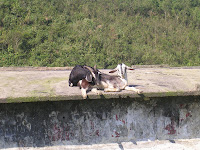
Back in August, Bao and I decided to take a holiday before Tet, and go to Danang and Hoi An. Arranging travel at Tet gets very difficult and planes and trains get booked up quickly. However, I was able to get a discount fare on Jetstar for the return leg easily. We had decided to travel to Danang by train, but ...
Train tickets can only be booked 2 months in advance. Not a problem, I thought. Just come back to the booking office on the right date. So I returned, only to be told there were no tickets available. To confuse things further, Bao had been told by a booking agent that there were tickets, and we had read in the Vietnamese and English language newspapers that to cope with demand the VNR had introduced an SMS booking system. All the information on all the steps to take was set out clearly in the papers. All except the number to send an SMS too!
In the end I was able to get the last two seats available on the last plane available travelling from HCM City to Danang, but at full economy fare. Here we come!
 Danang
DanangDanang is in the centre of Vietnam, a few hours drive south from Hue, and is the fourth-largest city in Vietnam. The government has always targetted the city for
economic development, and it holds a major port as well as many factories and production facilities.
However, the main attractions for us were visiting the Cham Sculpture Museum, Hai Van Pass, the Marble Mountains and the beaches, which leave Vung Tau for dead. Danang is also the access point to Hoi An when travelling by plane or train. We had also hoped to visit
Ba Na Hill Station but the road is very steep, and the chair lift which completes the journey was already closed for Tet. So that will be for another time ...

We spent the first day on foot. By the river we came across a large number of sculptures. Unlike Vung Tau, where the sculptures are in the park at Front Beach,this installation seemed temporary. We also visited the
Museum of Cham Sculpture, which was established by the same French School of the Far East that initiated the explorations and restorations at Angkor Wat. The two civilisations were linked by religion and tradition, but the Cham civilisation in Vietnam actually predates the Khmers.
From here we crossed the river to visit some pagodas mentioned in the guidebooks and take a look at the beaches which stretch from Nui Son Tra (Monkey Mountain) at the northern end for 30km down to Hoi An. Westerners know parts of this beach as China Beach, which was a major R&R station for the Americans during the war.

Danang is a large city, and the weather was hot even though it was nominally winter. Actually Danang is right on the point where Vietnam's climate changes from two seasons in the south (sunny and rainy) to four seasons in the north. We decided that we'd had enough of walking and opted to rent a motorbike from the hotel for the following day's trip to ...
Marble MountainsDavid and I made a fleeting visit to this popular tourist destination in 1999. Fleeting because we were en route from Hoi An to Hue, and because the moment we got off the bus we were swarmed by touts and kids, eager for money through legitimate and not-so-legitimate means. We abandoned all thought of visiting the mountains which are made of limestone and marble, and are full of caves and temples.
This time Bao and I rode south from Danang and had a completely different experience. The first thing that struck me, though, was that the small village of Non Nuoc has grown considerably and is just about absorbed into greater Danang as one long contiguous settlement from the city to Hoi An. There are still fields under cultivation but as you look out at the beach area you can see the sand dunes rapidly being subsumed by resorts and hotels, some of them massive piles. The other thing that we learned is that the marble that makes the site so miraculous has been so extensively exploited for sculptures and souvenirs that it is no longer used, for fear that the mountains and the tourist attraction will be gone. Instead the marble is now imported.




There are five mountains, each named for one of the elements in Eastern philosophy: water, metal, fire, wood, earth. The largest mountain is water - Thuy Son - and it is this one that we explored extensively through the caves and temples and climbing up to the highest points to look out over the landscape. Because it was a relatively clear day we could see way back up the coast to Nui Son Tra. The most recent cave development takes visitors deep inside the mountain and takes advantage of ups and downs to present the deepest hells and highest heavens in the Buddhist world.
Nui Son Tra and Hai Van PassIn the afternoon we drove back north to visit Nui Son Tra, nicknamed Monkey Mountain by the Americans. We spent part of the time lazing beside a stream before driving around this massive peninsular that forms the bay of Danang, along with the Hai Van mountains on the northern side. Later we visited the gigantic statue of Quan Am that we could see facing the East Ocean.

The next morning we drove up the Hai Van Pass. This used to be the only route north, but in 2005 a tunnel was built under the mountains. This is now used by cars and coaches, but motor bikes and trucks must still use the pass which gives majestic views up and down the coast, and which had been a strategic military post throughout Vietnam's struggles for nationhood.